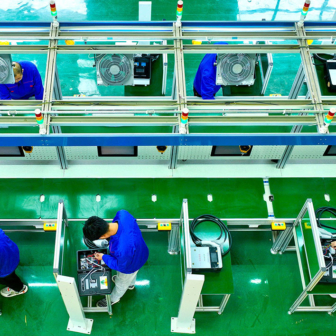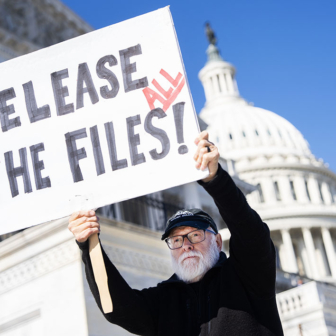Incompetence or conspiracy? As the old adage goes, the right answer is nearly always the former. Looking at the US response to Covid-19, you would have to think that they couldn’t do worse if they tried.
But perhaps they did try?
We know that Donald Trump’s economic adviser, Peter Navarro, circulated a memo on 29 January accurately predicting the stark choice faced by the United States: a strategy of aggressive containment, with immediate economic costs, or a strategy of no containment, with the deaths of perhaps a million Americans and, down the track, trillions of dollars in lost economic activity.
Navarro is the American administration’s leading China hawk. He has been pushing for the United States to “decouple” its economy from China’s and sever trade ties. His 2011 book with Greg Autry, Death by China, argues that the United States and China are on a path to armed conflict. His 2006 book, The Coming China Wars, does exactly what it says on the tin.
The trajectory of the US administration’s Covid-19 response has been consistent with a calculated effort to ensure SARS-CoV-2 spreads as widely as possible across the country. Begin by denying the seriousness of the disease; shut borders only after sufficient cases have been seeded to ensure major community spread; make a show of an urgent medical response when hospitals become overwhelmed then push to reopen the economy well before the epidemiology warrants it.
At the same time, the demonisation of China has ramped up. First came the administration’s insistence on using the term “Wuhan virus,” which was enough to scupper G20 summits and block the UN Security Council from agreeing to a resolution on the pandemic. Then came the scientifically implausible theory that the virus was engineered in the biosafety level 4 lab at the Wuhan Institute of Virology, amplified into a plank of US foreign policy by secretary of state Mike Pompeo. And then, most recently, came President Trump’s declaration that “the plague came over” from China and, in response, “We could cut off the whole relationship.”
Has the calculation been made that an American workforce with herd immunity will win the economic contest with a China having to manage containment? Or does it even matter to the administration who wins the economic contest? Is decoupling — and the division of the world into a United States bloc and a Sinosphere — the sole end?
Either way, the cost has been terrible. If this is a war between the United States and China, the body bags have already piled up. They are not being shipped back from some foreign battlefield; they are stacked in refrigerator trucks on New York backstreets or scheduled for hourly burial in rural Georgia.
The world is certainly dividing into two camps, one where containment of Covid-19 is the strategy and the other where it is not. Look at the map of daily cases per million population and the divide is sharp. Countries like Australia (currently running at 0.67) are in the group below 1. Countries with more than fifty times this rate include the United States, Britain, Russia, Belarus, Brazil and Saudi Arabia.
If this is the dividing line of a new global conflict, then Australia has already decided what side it is on. And China is on the same side.
Times of great peril require great decisions. When will the John Curtin moment arrive as we face down this pandemic? As every Australian schoolchild ought to know, when the Pacific war broke out at the end of 1941, Prime Minister Curtin turned Australia’s war effort away from Europe and to this region. “Without any inhibitions of any kind,” he declared to the Australian population, “I make it clear that Australia looks to America, free of any pangs as to our traditional links or kinship with the United Kingdom.”
This was a wrenching decision, horrifying to conservatives, but it was born of necessity. Should we have any pangs now in turning away from a belligerent “America First”?
But the Sudetenland has not yet been invaded. De-escalation is still possible.
Among the barriers to war are multilateral institutions, so it is no surprise that the United States has mounted a sustained attack on them, retreating from UNESCO, UNRWA (the agency for Palestinian refugees) and the UN Population Fund. It has crippled the World Trade Organization by refusing to allow appointments to the appeals body for resolving disputes, and this week, worn down by attrition, WTO director-general Roberto Azevêdo announced his departure a year before his term ends.
The WTO’s cardinal sin may have been to try to bring e-commerce into its purview with the goal of reconciling different views on issues like taxing data flows and preserving privacy. Alphabet (Google’s parent company), Facebook and Amazon are worth a collective US$2.6 trillion or so, around a tenth of the US economy. Even though the WTO has maintained a moratorium on tariffs on electronic transmission, the United States may reckon its advantage lies in a rules-free e-commerce world.
You’d hope that health would be exempt from this trade warfare. Historian Heidi Tworek shows in her wonderful account of the forerunner of the World Health Organization, the League of Nations Health Organization, that its persistence during the 1930s, even as international tensions rose, reflected countries’ mutual interest in rapidly sharing verified and consistent technical information on disease outbreaks.
So it is dismaying that the WHO has been a target when vested interests in conflict or its avoidance are in play. The Australian Strategic Policy Institute criticises the WHO, and through the WHO, China, but this is hardly a surprise from an organisation set up by John Howard with much of its funding from the defence department and arms manufacturers.
Can Australia play a role in deterring the weaponisation of this pandemic? It has been suggested that Australia punches above its weight in global health, but in my experience Australia is a lightweight when it comes to the real decisions that shape global health responses. Sure, Australian practitioners have a long record of making major contributions on the international stage, but a truly global Australian vision has been hampered by the old tendency to seek protection under the wing of a big power. So Australian assertiveness has been limited to the immediate region, as we see now with the government’s defence of the WHO being couched in terms of its regional impact or its tiny Pacific office.
Neither Australia nor the world will win from an escalation of conflict. In this case, conflict feeds on a false dichotomy: health or the economy. Opponents of lockdown and containment bemoan the economic losses compared with “before.” But a world without SARS-CoV-2 is the wrong counterfactual; policy choices are being made in the brute reality of a world where the virus exists. Even if governments abandon all restrictions on movement, people will still behave differently from how they behaved before Covid-19 because they want to keep themselves safe. Evidence from Google’s movement tracker showed significant reductions in US states well before lockdown orders were made. The right economic comparison is between economic activity under public health measures to minimise spread, and economic activity when people are fearful and deaths mount.
Australia is among the countries learning what a containment strategy may mean when only a tiny fraction of the population has been exposed to Covid-19. Case detection will be central, so expect testing to become ubiquitous. Fortunately, it has turned out that testing saliva is even more reliable than the awkward throat and nasal swabs that are taken now. It is not hard to imagine a near future when going to work might mean not only swiping your electronic passcard but also swiping your mouth and awaiting the virus all-clear before proceeding into the building.
Only an effective vaccine will decisively change the equation. At the pointy end of the rules-based international order is how the scramble for vaccine access will be managed. But we shouldn’t get too far ahead of ourselves: back in 2003 I was involved in an exercise to quantify demand for an HIV vaccine and establish parameters for its distribution; it was felt better to get this work done in advance of vaccine discovery, which was probably true, but here in 2020 an HIV vaccine is still as far off as ever.
While still formidable, the challenge of developing a vaccine for Covid-19 is probably less difficult than for HIV. What is beyond doubt is that demand will outstrip supply.
On this front, there have already been preliminary skirmishes. Back in March, the United States was accused of trying to buy out German company CureVac to secure access to its vaccine work, and last week the chief executive of French drugs multinational Sanofi sparked outrage when he said that the US government has “the right to the largest pre-order” of its vaccine under development “because it’s invested in taking the risk.”
At the forefront of establishing global rules for equitable vaccine access is the European Union. These rules will be considered at this week’s closely watched meeting of the World Health Assembly, the governing body of the WHO. Meanwhile a galaxy of stars in the global international order, including the serving leaders of South Africa, Pakistan, Senegal and Ghana, together with dozens of former leaders, have issued a call for “a people’s vaccine,” demanding that all vaccines, treatments and tests be patent-free, mass-produced, distributed fairly and made available to all people, in all countries, free of charge.
The tone was very different in the Rose Garden of the White House at last week’s announcement of “Operation Warp Speed,” the “America first” push for a vaccine. In a remark at once revealing and inaccurate, Trump asserted that the United States would cooperate with other countries, but not on equal terms: “We’re all working very closely together, and they’re viewing us as the leader, and we are — the relationship with other countries on solving this problem has been incredible.”
But there was no doubt that the vaccine would be for Americans only, and remarkably, for the launch of a vaccine development initiative, Trump mentioned the military at least ten times. “We have the mightiest military in the long history of humankind,” he said. “We have the best and most devoted workers ever to walk the face of the Earth. And now we’re combining all of these amazing strengths for the most aggressive vaccine project in history. There’s never been a vaccine project anywhere in history like this.”
There may be malice in this warlike posture, or it may just be braggadocio to cover up the very real difficulties of coherence and coordination from an administration elected for its skill in polarisation.
It is a strange moral universe we live in, where the assumption of systematic incompetence is more palatable than the alternative: the pure evil of a calculated jettisoning of half a million lives for the sake of a game of selective economic advancement. •




